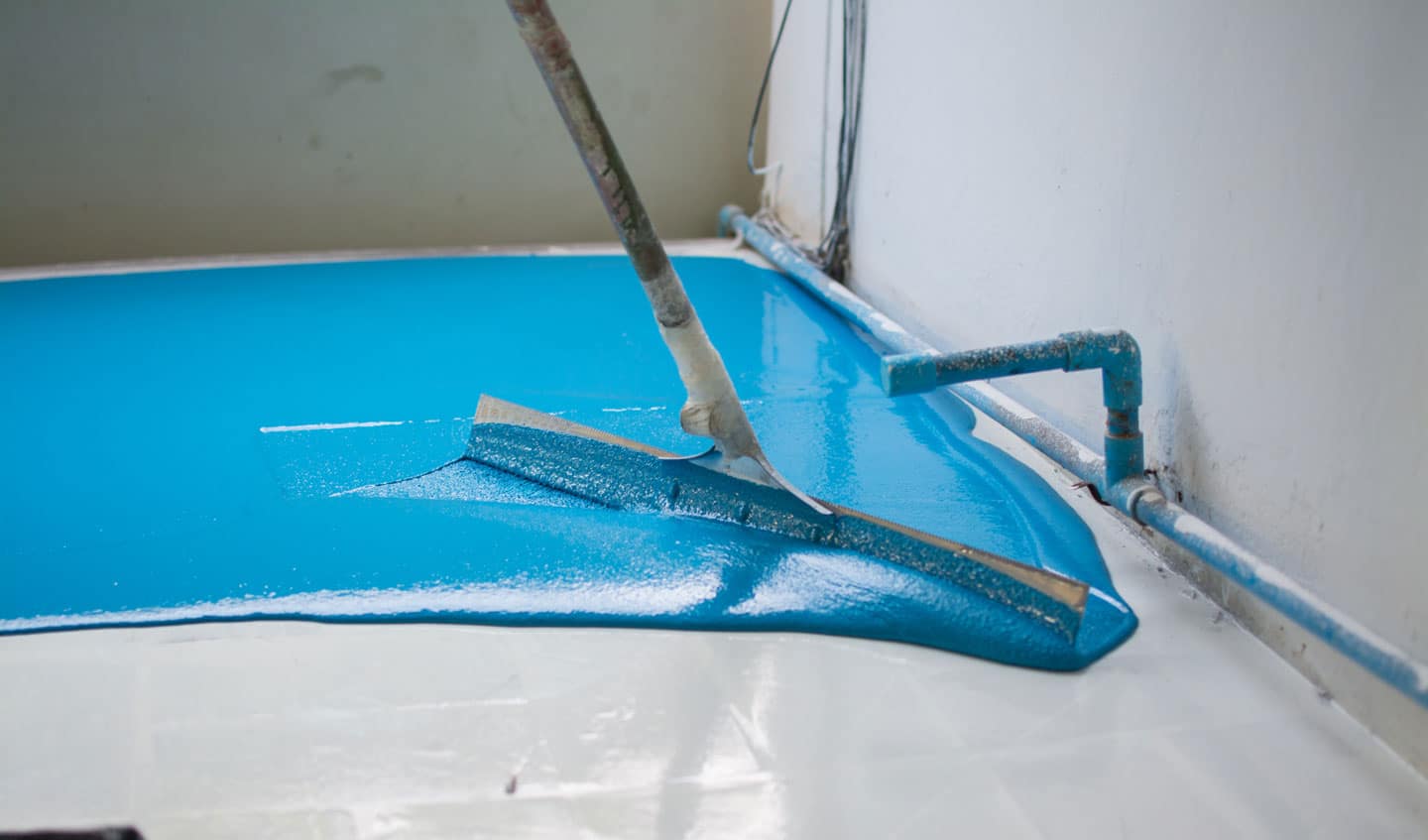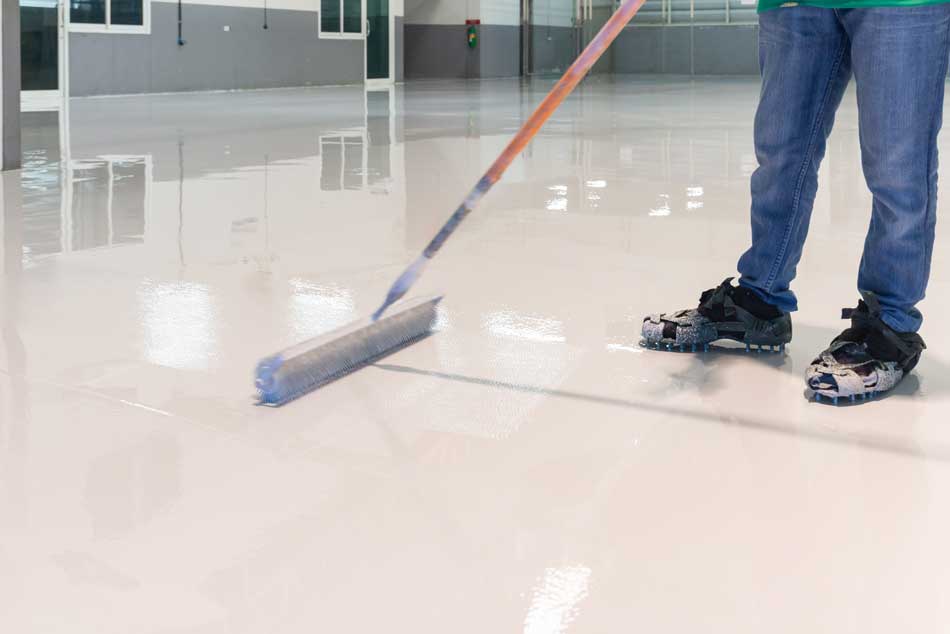Choosing the right floor coating for your garage can be challenging. You’ve probably heard of epoxy, but you may not have heard about polyaspartic floor coatings.
This article is part of an ongoing series where we examine different options head-to-head to see which is right for you.
We’ll give a brief overview of each type of coating before diving into the pros, cons, and what to expect during installation. Finally, we’ll talk briefly about who should get polyaspartic vs epoxy and vice-versa.
For more in this series, check out our other floor coating comparison articles:

What Is an Epoxy Coating?
Epoxy floors are a two-part mixture of epoxide resin and polyamine hardener. This adds a durable layer on top of the concrete floor to protect it.
Epoxy has been extremely popular with homeowners looking to protect their concrete garage floors for decades. It provides a custom look to your garage floor while resisting impacts and chemicals.
Not all epoxy is created equally, however.
Manufacturers have tried to create epoxy options at various price points, durability, and hardness.
For example, Home Depot sells epoxy paint, which has little in common with professional epoxy coatings. Similarly, epoxy coatings are ranked based on the amount of water included in the mixture. Coatings with less water (high solids) are thicker and more durable.
There is a wide range of unique colors for epoxy garage floor coatings. While you can find DIY epoxy garage flooring kits in retail stores, I recommend hiring a professional installer for better results.
Pros
- Affordable: Epoxy floor coatings are available in different price ranges, from inexpensive DIY kits to showroom-style coatings installed by professionals.
- Durable: Epoxy has a long curing time, making it dry hard. As a result, your garage floor will withstand the stresses and strains of foot and vehicle traffic.
- Resists chemicals: Battery acid and oil spills won’t damage your epoxy garage floor.
- Wide variety of colors: You can customize your garage floor with your favorite choice of color.
- Excellent adhesion: Epoxy’s long curing time allows it to form a permanent bond with your concrete floor.
- Long pot life: Epoxy won’t dry in the bucket before completing your project.
Cons
- Long curing time: Epoxy takes around 72 hours to cure enough to walk on and up to a week to be able to drive on.
- Reduces air quality: Over time, the chemicals in your epoxy floor will slowly bubble up to the surface and evaporate. This process is called out-gassing. It can reduce air quality if your garage doesn’t have suitable ventilation.
- Sensitive to UV exposure: Epoxy might fade or yellow if exposed to UV rays, reducing its quality.
- Slippery: Epoxy floors can be slippery when wet.
Applying Epoxy Floor Coating
Epoxy floor coatings are typically applied over an additional primer layer, which requires a long curing time. The primer soaks into your concrete and helps provide a more stable base for the epoxy coating to adhere to.
After the primer dries, mix epoxy resin and hardener together. Working in small sections, pour the mixture across the garage floor.
Spread the epoxy evenly across the floor section using a floor squeegee or roller. Use a bristle brush to paint the edges of the garage.
Once the first coating is dry, apply the second layer and allow it to rest for up to one week before parking your cars inside the garage to avoid picking up the coating.
If you want extra protection against slippage, add non-skid decorative vinyl color flakes while it is still wet. Depending on how much coverage you want, you may need an additional epoxy top coat to seal in the color chips.
Because of its longer pot life, epoxy resin won’t dry in the bucket while being applied. The first coating will take around 16 hours to dry if temperatures exceed 77 degrees. Lower temperatures may increase this up to 24 hours to dry.
Drying time might vary depending on your area’s climate. Allow your new epoxy garage floor to cure for about one month before doing any heavy-duty tasks that may scratch the floor.

What Is Polyaspartic Coating?
Polyaspartic is aliphatic polyurea, a mixture of ester and other components. It’s a newer type of floor coating, becoming popular as a corrosion-resistant component.
Like epoxy coatings, polyaspartic is a two-part system, mixing resin with a catalyst to cure it into a durable coating.
Polyaspartic floor coating is an excellent alternative to epoxy, though it does have its disadvantages.
Polyaspartic takes considerably less time to dry and emits fewer gases than epoxy, making it a more versatile alternative and easier for amateurs to install.
Applying a polyaspartic coating without additives gives a clear, glossy finish that won’t yellow over time. Most homeowners prefer it for that ‘wet look,’ even though the floor is completely dry.
Like epoxy, you can add unique colors and a non-slip texture to your garage floor.
However, you won’t find polyaspartic garage floor coatings in your local home improvement store. They’re only being installed professionally by dedicated flooring companies.
Pros of Polyaspartic Floor Coating
- Weather-resistant: Polyaspartic floor coatings will bond and dry perfectly at -30° to +140° Fahrenheit, unlike epoxy, which prefers warmer temperatures to dry quickly.
- Fast curing time: Polyaspartic cures in an hour or less. That’s about five times faster than epoxy.
- Durable: Polyaspartic dries hard while maintaining some flexibility. That makes your garage floor particularly scratch-resistant.
- UV resistant: Polyaspartic coating won’t fade or yellow even after exposure to UV rays.
- Good air quality: Polyaspartic has low VOCs and is odorless. It also doesn’t release fumes during application.
- Stain-resistant: Polyaspartic was first meant to prevent steel from rusting. Applying it on a garage floor will make your floor stain-resistant.
Cons
- Expensive: Unlike epoxy, polyaspartic comes at a higher cost.
- Short pot life: Polyaspartic dries faster and might dry in the bucket before completing the job.
- May require professional application: A DIY application is tricky because you have to spread it evenly and at a higher speed.
Applying Polyaspartic Floor Coating
The initial steps to apply a polyaspartic coating are the same as for epoxy or polycuramine. Your garage floor needs to be clean and dry, and it also needs to be sanded to allow the coating to adhere to the concrete.
To get started, grab a floor squeegee. Pour ribbons of the coating across the concrete floor and use the squeegee to spread it evenly.
Because polyaspartic dries quickly, you’ll need to work faster while avoiding unnecessary hiccups. Given its limited pot life, delaying the application process could lead to the drying of polyaspartic in the bucket, which will waste your materials and time.
In about one hour or less, your first coat will be dry. Apply the second layer and include your favorite non-skid traction material, like color flakes or granules.
Unlike epoxy, applying polyaspartic coating will take less than a day. Once it’s done, your garage floor will be ready for use after 24 hours.
Polyaspartic Vs Epoxy: Which Is Better for Your Garage Floor?
Determining which coating is better depends on what you’re looking for and your priorities in a floor coating.
Epoxy is the cheaper coating option but will take longer to apply and dry. On the other hand, polyaspartic is relatively expensive but takes less than an hour to dry and only a few hours to apply.
Polyaspartic is highly durable and maintains some flexibility after drying, which makes it stain and scratch-resistant. It’s also UV resistant, meaning it won’t fade or yellow after exposure to ultraviolet rays.
Epoxy is durable but requires regular maintenance.
After drying, epoxy becomes rigid and is easily susceptible to scratches. It’s also UV sensitive, meaning it will fade and yellow when exposed to UV rays. Epoxy garage floors usually need to be replaced between two and ten years, depending on the type of epoxy used.
In both cases, if there is significant damage to the floor, it’s better to redo the job than try to patch it up. Finally, both epoxy and polyaspartic will give you a great-looking garage floor while protecting your cement from dings and scratches.
